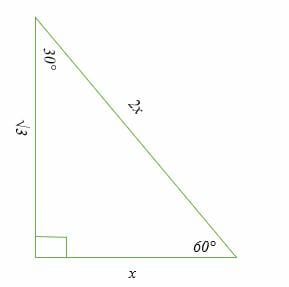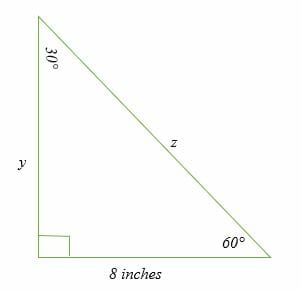- Home
- >
- 30°-60°-90° Triangle – Explanation & Examples
30°-60°-90° Triangle – Explanation & Examples
 When you’re done with and understand what a right triangle is and other special right triangles, it is time to go through the last special triangle — the 30°-60°-90° triangle.
When you’re done with and understand what a right triangle is and other special right triangles, it is time to go through the last special triangle — the 30°-60°-90° triangle.
It also carries equal importance to the 45°-45°-90° triangle due to the relationship of its side. It has two acute angles and one right angle.
What is a 30-60-90 Triangle?
A 30-60-90 triangle is a special right triangle whose angles are 30º, 60º, and 90º. The triangle is special because its side lengths are always in the ratio of 1: √3:2.
Any triangle of the form 30-60-90 can be solved without applying long-step methods such as the Pythagorean Theorem and trigonometric functions.
The easiest way to remember the ratio 1: √3: 2 is to memorize the numbers; “1, 2, 3”. One precaution to using this mnemonic is to remember that 3 is under the square root sign.

From the illustration above, we can make the following observations about the 30-60-90 triangle:
- The shorter leg, which is opposite to the 30- degree angle, is labeled as x.
- The hypotenuse, which is opposite to the 90-degree angle, is twice the shorter leg length (2x).
- The longer leg, which is opposite to the 60-degree angle, is equal to the shorter leg’s product and the square root of three (x√3).
How to Solve a 30-60-90 Triangle?
Solving problems involving the 30-60-90 triangles, you always know one side, from which you can determine the other sides. For that, you can multiply or divide that side by an appropriate factor.
You can summarize the different scenarios as:
- When the shorter side is known, you can find the longer side by multiplying the shorter side by a square root of 3. After that, you can apply Pythagorean Theorem to find the hypotenuse.
- When the longer side is known, you can find the shorter side by diving the longer side by the square root of 3. After that, you can apply Pythagorean Theorem to find the hypotenuse.
- When the shorter side is known, you can find the hypotenuse by multiplying the shorter side by 2. After that, you can apply Pythagorean Theorem to find the longer side.
- When the hypotenuse is known, you can find the shorter side by dividing the hypotenuse by 2. After that, you can apply Pythagorean Theorem to find the longer side.
This means the shorter side acts as a gateway between the other two sides of a right triangle. You can find the longer side when the hypotenuse is given or vice versa, but you always have to find the shorter side first.
Also, to solve the problems involving the 30-60-90 triangles, you need to be aware of the following properties of triangles:
- The sum of interior angles in any triangle adds up to 180º. Therefore, if you know the measure of two angles, you can easily determine the third angle by subtracting the two angles from 180 degrees.
- The shortest and longest sides in any triangle are always opposite to the smallest and largest angles. This rule also applies to the 30-60-90 triangle.
- Triangles with the same angle measures are similar, and their sides will always be in the same ratio to each other. The concept of similarity can therefore be used to solve problems involving the 30-60-90 triangles.
- Since the 30-60-90 triangle is a right triangle, then the Pythagorean theorem a2 + b2 = c2 is also applicable to the triangle. For instance, we can prove the hypotenuse of the triangle is 2x as follows:
⇒ c2 = x2 + (x√3)2
⇒ c2 = x2 + (x√3) (x√3)
⇒ c2 = x2 + 3x2
⇒ c2 = 4x2
Find the square root of both sides.
√c2 = √4x2
c = 2x
Hence, proved.
Let’s work through some practice problems.
Example 1
A right triangle whose one angle is 60 degrees has the longer side as 8√3 cm. Calculate the length of its shorter side and the hypotenuse.
Solution
From the ratio x: x√3: 2x, the longer side is x√3. So, we have;
x√3 = 8√3 cm
Square both sides of the equation.
⇒ (x√3)2 = (8√3)2
⇒ 3x2 = 64 * 3
⇒ x 2 = 64
Find the square of both sides.
√x2 = √64
x = 8 cm
Substitute.
2x = 2 * 8 = 16 cm.
Hence, the shorter side is 8 cm, and the hypotenuse is 16 cm.
Example 2
A ladder leaning against a wall makes an angle of 30 degrees with the ground. If the length of the ladder is 9 m, find;
a. The height of the wall.
b. Calculate the length between the foot of the ladder and the wall.
Solution
One angle is 30 degrees; then this must be a 60°- 60°- 90°right triangle.
Ratio = x: x√3: 2x.
⇒ 2x = 9
⇒ x = 9/2
= 4.5
Substitute.
a. The height of the wall = 4.5 m
b. x√3 = 4.5√3 m
Example 3
The diagonal of a right triangle is 8 cm. Find the lengths of the other two sides of the triangle given that one of its angles is 30 degrees.
Solution
This is must be a 30°-60°-90° triangle. Therefore, we use the ratio of x: x√3:2x.
Diagonal = hypotenuse = 8cm.
⇒2x = 8 cm
⇒ x = 4cm
Substitute.
x√3 = 4√3 cm
The shorter side of the right triangle is 4cm, and the longer side is 4√3 cm.
Example 4
Find the value of x and z in the diagram below:

Solution
The length measuring 8 inches will be the shorter leg because it is opposite the 30-degree angle. To find the value of z (hypotenuse) and y (longer leg), we proceed as follows;
From the ratio x: x√3:2x;
x = 8 inches.
Substitute.
⇒ x√3 = 8√3
⇒2x = 2(8) = 16.
Hence, y = 8√3 inches and z = 16 inches.
Example 5
If one angle of a right triangle is 30º and the shortest side’s measure is 7 m, what is the measure of the remaining two sides?
Solution
This is a 30-60-90 triangle in which the side lengths are in the ratio of x: x√3:2x.
Substitute x = 7m for the longer leg and the hypotenuse.
⇒ x √3 = 7√3
⇒ 2x = 2(7) =14
Hence, the other sides are 14m and 7√3m
Example 6
In a right triangle, the hypotenuse is 12 cm, and the smaller angle is 30 degrees. Find the length of the long and short leg.
Solution
Given the ratio of the sides = x: x√3:2x.
2x = 12 cm
x = 6cm
Substitute x = 6 cm for the long and short leg to get;
Short leg = 6cm.
long leg = 6√3 cm
Example 7
The two sides of a triangle are 5√3 mm and 5mm. Find the length of its diagonal.
Solution
Test the ratio of the side lengths if it fits the x: x√3:2x ratio.
5: 5√3:? = 1(5): √3 (5):?
Therefore, x = 5
Multiply 2 by 5.
2x = 2* 5 = 10
Hence, the hypotenuse is equal to 10 mm.
Example 8
A ramp that makes an angle of 30 degrees with the ground is used to offload a lorry that is 2 feet high. Calculate the length of the ramp.
Solution
This must be a 30-60-90 triangle.
x = 2 feet.
2x = 4 feet
Hence, the length of the ramp is 4 feet.
Example 9
Find the hypotenuse of a 30°- 60°- 90° triangle whose longer side is 6 inches.
Solution
Ratio = x: x√3:2x.
⇒ x√3 = 6 inches.
Square both sides
⇒ (x√3)2 = 36
⇒ 3x2 = 36
x2 = 12
x = 2√3 inches.
Practice Problems
- In a 30°- 60°- 90° triangle, let the side across from the 60° angle is given as 9√3. Find the length of the other two sides.
- If the hypotenuse of the 30°- 60°- 90° triangle is 26, find the other two sides.
- If the longer side of a 30°- 60°- 90° triangle is 12, what is the sum of the other two sides of this triangle?
